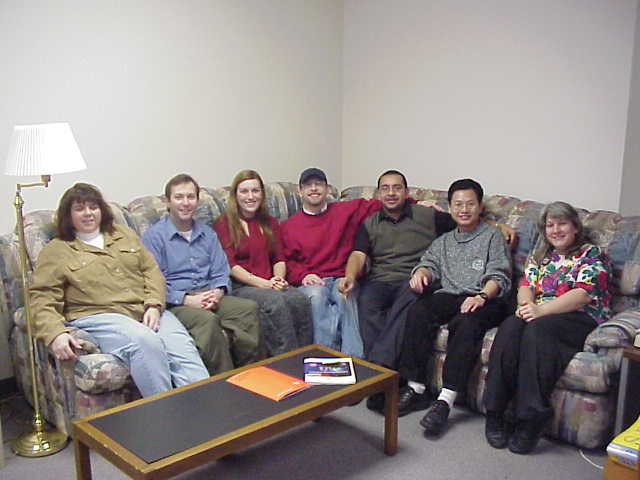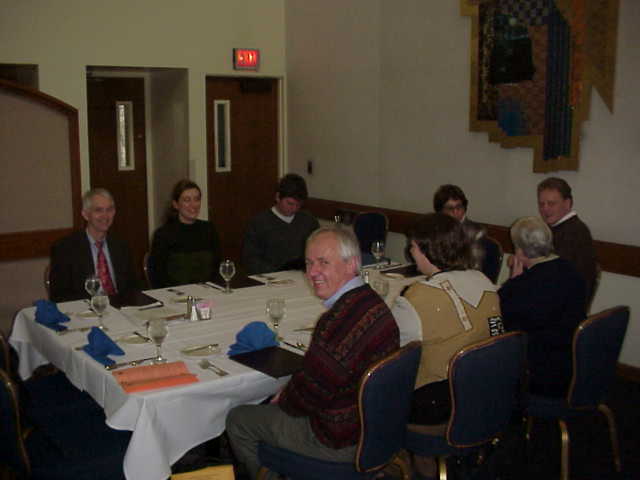UK
PFCF workshop at SSCA 2202
UK PFCF organized
an interactive a workshop at the SSCA Convention 2002 in
Winston-Salen (NC) on April 5th 2002. The title of the
presentation was "PREPARE TO THRIVE IN ACADEME: AN NCA
WORKSHOP ON WHAT COMMUNICATION DOCTORAL STUDENTS NEED TO KNOW"
The workshop was presented for
doctoral students to acquaint them with the array of roles,
responsibilities, and opportunities that await them as the
professoriate of the 21st century. Prof. Derek Lane, prof. Enid
Waldhart, with the assistance of Davide Girardelli discussed
what graduate students need to know about teaching, research,
service/engagement and how they, as aspiring faculty members,
can prepare for careers in a variety of institutional settings.
The workshop has generated a lot of interest and discussion.
Prof. Jim Gaudino, NCA past President, was amongst the
participants of the workshop.
The content
of the excellent and insightful presentation will be soon on
line!!!
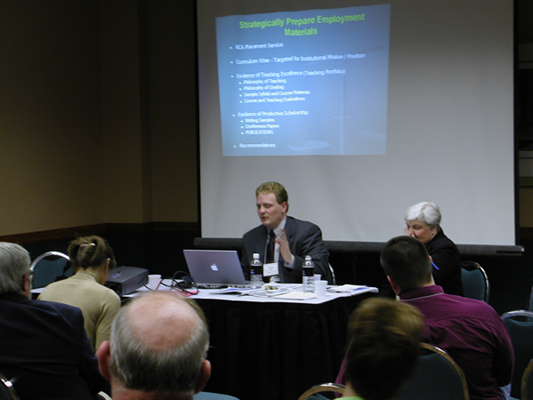
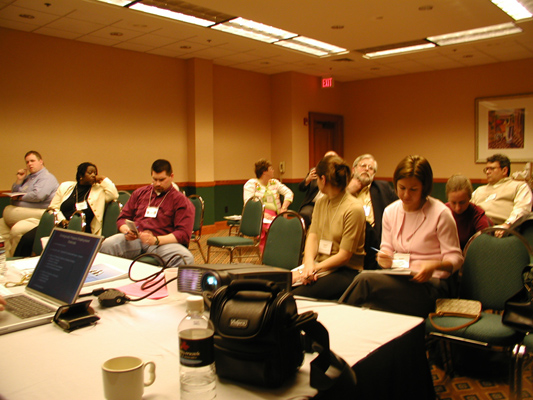
>>TOP
"Life
on the tenure track:" A thought-provoking piece from the
"TOMORROW'S PROFESSOR(SM) LISTSERV"
----------------------------------------------------------------------
TOMORROW'S PROFESSOR(SM) LISTSERV
"desk-top faculty development, one hundred times a
year"
STANFORD UNIVERSITY LEARNING LABORATORY (SLL)
http://sll.stanford.edu/
Note: Previous Listserv postings can be found at:
http://sll.stanford.edu/projects/tomprof/newtomprof/postings.html
----------------------------------------------------------------------
LIFE ON THE TENURE TRACK: A SEVEN-YEAR CRUCIBLE
Junior
faculty speak out on the challenges;
officials
lay out new programs that help young scholars
BY JOHN SANFORD
A faculty position at Stanford offers prestige, a dynamic
intellectual atmosphere and plenty of resources. For newly
minted doctors of philosophy, it also promises a distinguished
inauguration to the professoriate.
But life at Stanford can be costly, literally and figuratively.
Discussing Bay Area housing prices tends to send junior
faculty into fretting jags about their finances, and the general
stress of meeting extremely high scholarly expectations, while
teaching courses and juggling other obligations, can exact a
toll. In addition, some junior faculty worry about the
university's commitment to tenure-track positions; they wonder
whether Stanford will take the path of some of its peer
institutions, most notably Harvard and Yale, in awarding tenure
quite infrequently.
These are just a few of the sentiments that emerged during
conversations here with eight assistant professors and three
recently tenured associate professors who were asked to discuss
their views on being junior faculty members at the Farm. Acutely
aware of their
probationary status, some assistant professors would speak only
on the condition of anonymity. Here is some of what they had to
say.
TENURE
The practice of granting some university faculty lifetime
employment, with only the vague possibility of termination for
incompetence or moral turpitude, grew out of the notion that
good scholarship demands academic freedom. Champions of the
tenure system, which was codified in the United States about 60
years ago by the American Association of University Professors,
argue that the best research thrives where scholars don't face
the threat of being fired for the work they do or the ideas they
express.
But with such liberating guarantees comes what amounts to a six-
or seven-year crucible for assistant professors, who may find
themselves plagued with anxiety about their performance. Have
they discomfited important and influential higher-ups with their
methods and ideas?
Are they publishing in the right journals? Is their research out
of fashion or, worse, has it been trumped recently by a peer at
another institution?
And while not purely a gamble, a bid for tenure at a renowned
research university like Stanford comes with inherent risks.
"While it's very clear what it takes to get tenure, in a
sense it's not quantifiable," said an assistant professor
in the School of Humanities and Sciences. "You just sort of
have to achieve excellence. And it's not like you can set
yourself a plan to do this. You can't just say, 'My next book
will be a smash hit.' "
Jennifer Summit, an associate professor of English who was
awarded early tenure last spring, agreed. "I think most of
us accept that a certain amount of stress comes with the
job," she said. "I don't know any assistant professor
who doesn't want to be an excellent teacher or to produce the
best work he or she can -- surely that's why we all entered the
profession."
But welcoming the challenges does not translate automatically
into a promotion. Pat Jones, a professor of biological sciences
and vice provost for faculty development, acknowledged that
the standards for hiring and awarding tenure have become more
stringent over the past couple of decades.
Yet in discussions about the ascent of the tenure bar, some
factors sometimes go unmentioned. One is obvious: As a
research university gains in prestige, it will have greater
expectations for its professors; a higher tenure bar results
simply from natural growth and development.
Statistics provided by the Office of the Provost show that while
tenure rates jump around from year to year, there has been
no consistent trend -- either upward or downward -- over the
past two decades. Take, for example, tenure rates in the largest
school, the School of Humanities and Sciences: 32.3 percent of
assistant professors hired from 1974 to 1978 eventually earned
tenure; 50.5 percent hired from 1979 to 1983 earned tenure; and
41.2 percent hired from 1989 to 1993 earned tenure.
Several assistant professors said the climate for Stanford's
junior faculty has improved over the past few years. In previous
years, "while demanding high levels of achievement for
tenure, the university offered very little support to junior
faculty in order to help them establish productive and
successful careers," Summit said. An increase in research
funds and the creation of the School of Humanities and Sciences'
Junior Faculty Leave Policy "have made a tremendous
difference," she added. The leave policy began in 1998 and
permits assistant professors to take a sabbatical during their
fifth or sixth year to prepare for tenure review. This often
means completing a book, article or research project.
But whether Stanford will remain devoted to tenure-track
positions, or increasingly start to recruit senior faculty from
other institutions, is a question that troubles some junior
faculty. Assistant Professor Fernando Gomez of the Department of
Spanish and Portuguese asserted that granting junior faculty
tenure results in a stronger university. "You've got to
build from below with people from inside who have been in the
trenches since day one," he said.
On one hand, a university of Stanford's caliber must devote
resources to attracting and retaining faculty stars, but Jones
and Provost John Etchemendy emphasized Stanford's commitment to
making junior appointments with the intention that they will be
seriously considered for tenure. By way of illustration,
Etchemendy recalled that the last presidential search committee,
composed of six faculty members and seven trustees, considered
what they wanted the university's core values to be. Supporting
need-blind admission and offering junior faculty "a very
real chance of getting tenure" were the top two items on
the list, Etchemendy said. "That's a pretty ringing
endorsement," he added.
Denying tenure is agonizing for the university as well as for
the assistant professor in question, he continued.
"It's a failure of the department and the university to
nurture that
person," he said. "So all along the way, people are
pulling for that assistant professor to earn tenure. But that
doesn't mean it's easy."
Opinions vary on whether the overall tenure expectations are
quitable. "They are clear in that I know that I have to be
a real leader in my field to have any chance of making it,"
said an
assistant professor of business. "They are not clear in
terms of having objective standards that I know I have to
attain, but that would be an inappropriate way for the
university to assess people. I suppose it is possible to worry
about the fairness or the highly subjective nature of the
ultimate decision."
That decision is based significantly on review letters written
by peers from other institutions. The candidate and evaluation
committee suggest these external referees. In the School of
Humanities and Sciences, 10 to 15 letters are required; but to
obtain that number, a department may solicit as many as 18
letters, and possibly more.
Brad Gregory, an associate professor of history, said he
believes that the number of letters required is too high but
that, as a whole, the system makes sense. "I never felt
like I was being told one thing, whereas in reality expectations
were very different," he said.
An assistant professor in the School of Humanities and Sciences
echoed Gregory's sentiments about the letters.
"The humanities are so fractured these days that finding so
many qualified referees at peer institutions can be very
difficult," he said. "It may be different in the
natural and social sciences. I would like to think that six to
eight qualified letters would suffice."
Jones maintains that the importance of the tenure-review process
merits the large quantity of letters. She said it can work in
favor of the junior faculty member's tenure case; one poor
review among, say, six would reflect far worse than one bad
review among 12, she
said.
RESEARCH,
TEACHING AND SCHOLARLY LIFE
For professors, opportunities to participate in conferences and
forums and on faculty committees present themselves
nonstop, like the doughnuts out of the frenzied doughnut machine
in Homer Price. For junior faculty, these opportunities can suck
time away from
scholarly obligations that require immediate attention.
As the tenure clock ticks away, junior faculty must scramble to
finish their first or second book, or have a groundbreaking --
or at least noteworthy -- scientific article published.
As the new kids on the block, they also need to make their names
and work familiar to their peers -- especially the stars in
their discipline -- so that when the time comes these people can
be counted on to write tenure-review letters. Making such
inroads requires attending as many conferences as possible,
particularly the high-profile ones.
On top of this, assistant professors, especially those in the
sciences, must write grants to get research money, for which
they often have to compete with well-established senior
professors. The recourse to competing for the large grants is
applying to a multitude of small grants -- a process that is
more time-consuming. (Assistant professors in the natural and
applied sciences, including engineering, are offered funding
packages for research when they are hired at Stanford, and this
money may carry them through their first couple of years.)
With limited time, assistant professors need to be careful when
picking what to get involved in at Stanford, said Armando Fox,
an assistant professor of computer science. If, for example,
they feel compelled to join a university committee, they
should attempt to join one with people who can write
tenure-review letters for them, he said. Serving on committees,
while appreciated, is not a serious bonus when it comes to
making tenure. While committee participation may win
points for good citizenship, "it cannot make up for the
teaching or research record," Jones explained.
For Daniel McFarland, an assistant professor of education, the
biggest challenge is simply finding time and a quiet place to
write without interruptions. "The irony is, you're young
and full of ideas and have the energy to confront them, and the
hardest part is you find you don't have time to do that,"
he said. "It's not due to any one cruelty, it's just a fact
of starting out." An almost universal sentiment among
junior faculty is that the teaching load at Stanford is fair --
even generous -- compared to other American colleges and
universities. (Teaching loads generally range from two to four
classes a year, although this range can vary.) Most also said
they found teaching a rewarding aspect of the job. And while
both research and teaching demand time, several professors said
they did not consider the two in competition. "My teaching
has always fueled my research, and vice versa," Summit
said.
An assistant professor in the School of Humanities and Sciences
agreed. "Stanford allows pretty wide latitude in what one
teaches, so the classroom setting is a fine place to try out
ideas, pursue new lines of research, get students excited about
one's own interests,
etc.," he said.
While university officials maintain that both strong teaching
and scholarship are required to earn tenure, scholarship carries
the greater weight during tenure review. Assistant professors
said they generally feel free to pursue the kind of research
they're interested in, although the university's
intellectual structure occasionally imposes some constraints.
Amir Eshel, an assistant professor of German studies, also has
a strong interest and expertise in Hebrew
literature. Eshel said his tenure case, however, will depend on
the research he's done in German studies. He said this was a
"fair demand."
MENTORING
Approximately 22 percent of the overall faculty are tenure-line
assistant professors, according to September 2000 statistics
from the Provost's Office (the most recent published data).
These junior faculty members naturally look to their seniors for
guidance -- both in navigating the tenure track and getting tips
on more immediate matters about, say, developing a course.
"You're essentially thrown into something you've never done
before, and there's a very steep learning curve in many
areas," said Vijay Pande, an assistant professor of
chemistry and, by courtesy, of structural biology.
At Stanford, mentoring programs for junior faculty are
designed by individual schools or departments, but there are a
few broader policies as well, Jones said. For example,
department chairs across the university are expected to offer to
meet with assistant professors on an annual basis. The
administration has been pushing for a comprehensive,
university-wide mentoring policy, Jones said.
Assistant professors give mentoring programs mixed reviews. In
the School of Humanities and Sciences, the availability and
formality of such programs are inconsistent from one department
to the next. But Pande said he found the advice of senior
faculty quite valuable in setting and modifying a course toward
tenure review.
"Everybody in both departments has been wonderful. Mentors
have really been looking out for me," Pande said.
HOUSING AND
CHILDCARE
For junior
faculty, the academic challenges posed by Stanford can be met
with skill, brains and hard work, but these qualities may not be
as handy when it comes to facing down the financial challenges
of Bay Area living.
Indeed, the most common complaint among assistant professors
stems from the cost of buying a home in this region, which
continues to exasperate some despite last year's enhancements to
faculty and staff housing programs.
According to statistics from the Faculty/Staff Housing Office in
late 2000, an assistant professor earning $62,928 should be able
to afford a three-bedroom, two-and-half bathroom condominium
unit priced at $574,250 -- and even a property priced as high as
$724,000 --
assuming he or she can make a 10 percent down payment.
(Faculty/Staff Housing officials said these calculations were
based on assumptions about different salaries and different size
"target houses" for assistant, associate and full
professors, and about other income in
the household.)
But, as one professor noted, 10 percent of a $400,000 home is
still $40,000 -- a significant amount if a new professor is
saddled with graduate school debt and is helping to support a
family.
And the median salary for assistant professors in the School of
Humanities and Sciences (not including economics and the natural
sciences) was less than $60,000 during the 2000-01 academic
year, according to statistics prepared by the Office of the
Provost. The median salary for junior faculty in the social
sciences (excluding economics) during this period was $58,415;
for junior faculty in the humanities, this figure was $55,620.
For those in the natural
sciences and economics, the median salary was $62,000.
Meanwhile, the median price for a Redwood City home was roughly
twice as much as one in Cambridge, Mass., and more than three
times as expensive as the national median, according to MSN
HomeAdvisor, which based its statistics on home-sales data from
April 1999 to March
2000. (The median Palo Alto home costs more than three times as
much as that in Cambridge, and close to six times the national
median, according to MSN HomeAdvisor.)
However, for prospective homebuyers, the future is looking
brighter, Stanford housing officials say.
"The prices in this area have come down, and supply has
increased," said Carolyn Sargent, director of the
Faculty/Staff Housing Office.
"People worry about housing but usually feel reassured once
they get here," Sargent added, but acknowledged that
expensive housing is just a fact of life in the Bay Area.
"All we can do is try to present an affordable
alternative."
An assistant professor in the School of Humanities and Sciences
said he appreciates a taxable fringe benefit offered by the
university called the Housing Allowance Program (HAP),
which compensates new faculty and senior staff who buy homes.
The allowance comes simply as
additional income, and it shows up on the employee's paycheck.
But it does not go far enough, he said. Each year the housing
allowance, derived using a formula based on salary, is reduced
by one-ninth. (Thus, the maximum term of the allowance is nine
years.)
"Our salaries creep up relatively slowly and HAP goes down
relatively quickly," he said.
For Pande, loan assistance from the university was the
difference between being able to buy a home and not being
able to buy one. "[My house] is very small and near the
train tracks, but I'm happy with it," he said.
But those who cannot afford to buy a house may find they also
face exorbitant rental rates. Another assistant professor in the
School of Humanities and Sciences said building the Stanford
West Apartments was a great idea, but the rents are too high.
"I applied for a two-bedroom apartment and the cheapest one
available was $2,300. That's about 70 percent of my take-home
pay. That's not a workable solution," he said. Rents at the
complex for a two-bedroom apartment currently start at $2,142.
(A misunderstanding circulated last year that faculty would pay
no more than 30 percent of their household income toward rent at
Stanford West, Sargent said.)
Fox takes a somewhat different view of the housing costs.
"It's just not an issue that I'd expect the university to
be able to do anything about," he said. "If I got a
job at Columbia I wouldn't say, 'Oh, but you're in New York
City, and it's going to cost too much.' If I went to the
University of Washington, it would rain all the time and I can't
do anything about that."
In any case, university officials are quite sensitive to the
housing problems that have plagued the area over the past
half-dozen years, Jones said.
"I think the current administration ... is very attuned to
the impact of the cost of living on the quality of life and on
the ability of people to come," she said. "Of course,
how they're feeling about their jobs is going to affect what
they say to people who are coming to interview at Stanford
during this year. So if people are totally stressed and are
thinking, 'How am I ever going to be able to afford to
stay?' that's not going to be good for recruiting."
On top of the mortgage or rent, many assistant professors
must pay a great deal for childcare. To help out, the university
launched a pilot program at the start of the year giving
eligible employees with children 6 years old and younger as much
as $5,000 a year
(tax-free) for childcare costs.
For others, however, the cost is only one facet of the problem.
One assistant professor said he and his wife waited
two-and-a-half years before getting a spot for their child at a
campus daycare center. He was critical of the university's
handling of the matter in general.
"I think this whole [childcare subsidy initiative] is a
ruse, if you ask me, because it's a lot cheaper to give a few
faculty a few thousand dollars than to use campus land to
develop more daycare centers," he said.
Santa Clara County's General Use Permit for the university
allows, in fact, for another daycare center to be built on
campus, Jones said.
There are now roughly 550 children on waiting lists for one of
the two on-campus daycare centers, said Teresa Rasco,
director of the WorkLife Office. An additional 75 are on the
waiting list for the Rainbow School at Escondido Village, which
operates from 9 a.m. to 3
p.m.
However, a
new daycare center, Knowledge Beginnings, is set to open in
March at the Stanford West Apartments, and spaces are still
available, Rasco said.
THE BIG
PICTURE
Junior faculty interviewed for this article said they came to
Stanford knowing the stakes, as well as the rewards, were great.
"Stanford's reputation is no accident," said an
assistant professor in the Graduate School of Business.
"There are a lot of smart and interesting people around
here who provide useful ideas."
Fox agreed. "The biggest real benefit at a place like
Stanford is that pretty much anyone you work with is first
class," he said.
According to a professor in the School of Humanities and
Sciences, "You have some of the best colleagues you could
wish for, some of the best students you could find anywhere, an
amazing library and other scholarly resources, and really
generous financial resources. But
there's a constant and always growing sense of anxiety and
pressure. You don't take the job
thinking that it's otherwise."
---------------------------------------------------------------------
TOMORROW'S PROFESSOR LISTSERV is a shared mission partnership
with the
American Association for Higher Education (AAHE) http://www.aahe.org/
The National Teaching and Learning Forum (NT&LF) http://www.ntlf.com/
----------------------------------------------------------------------
---------------------
Note: Anyone can SUBSCRIBE to Tomorrows-Professor Listserv
by sending
the following e-mail message to: <Majordomo@lists.stanford.edu>
subscribe tomorrows-professor
To UNSUBSCRIBE to the Tomorrows-Professor send the following
e-mail
message
to: <Majordomo@lists.stanford.edu>
unsubscribe tomorrows-professor
----------------------------------------------------------------------
>>TOP
The
CJT 685 course is started!
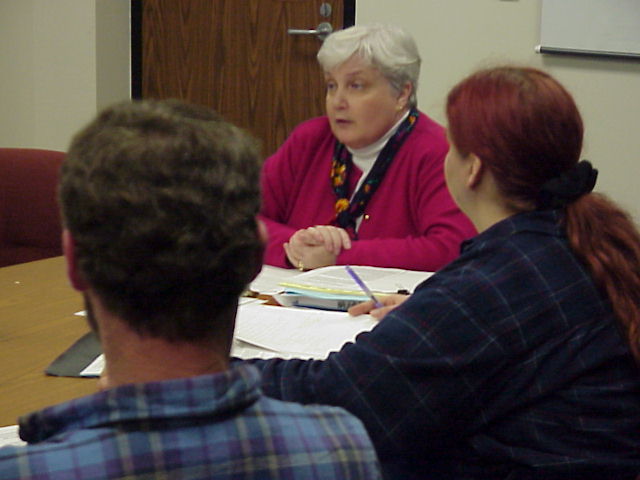
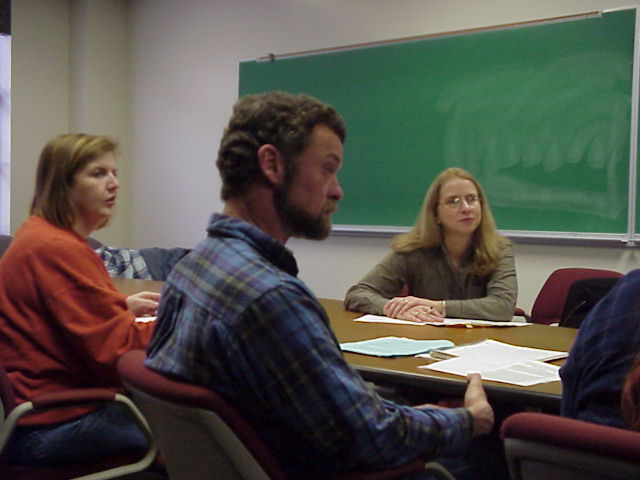
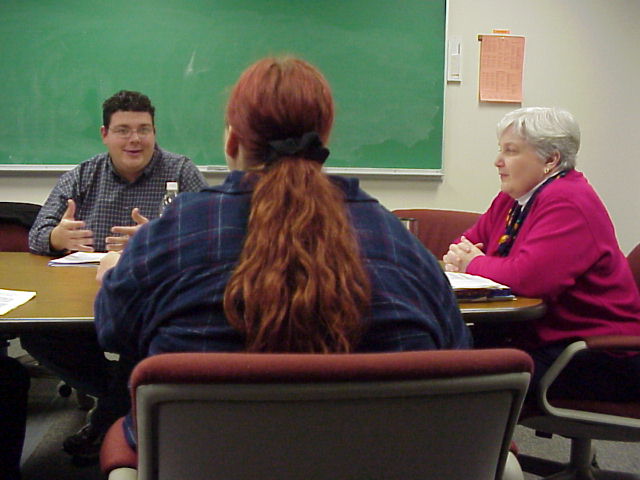
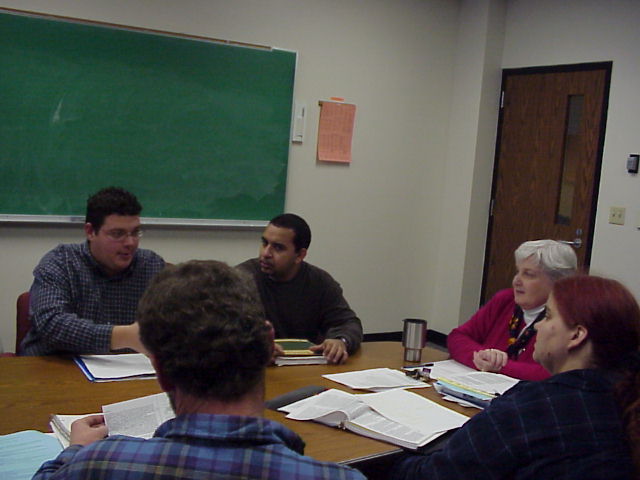
>>TOP
"Introducing
the New Faculty"
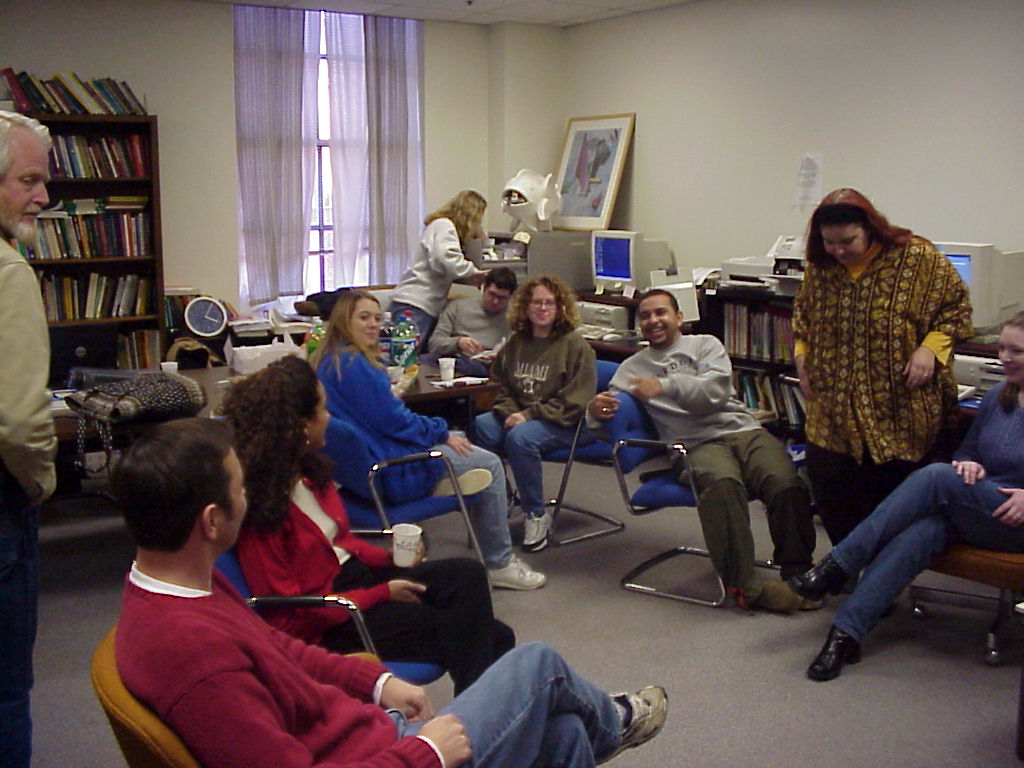
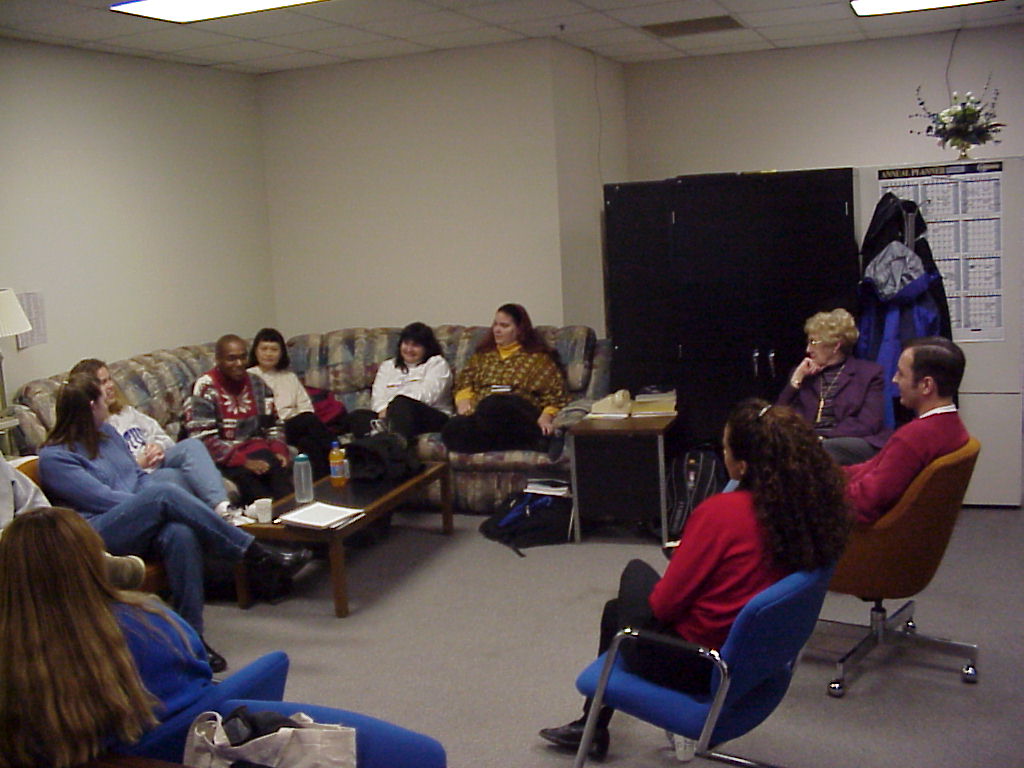
A huge and active audience showed up for
the colloquium dedicated to the "New Faculty Members,"
held on February 7th, 2002 at the Graduate Center.
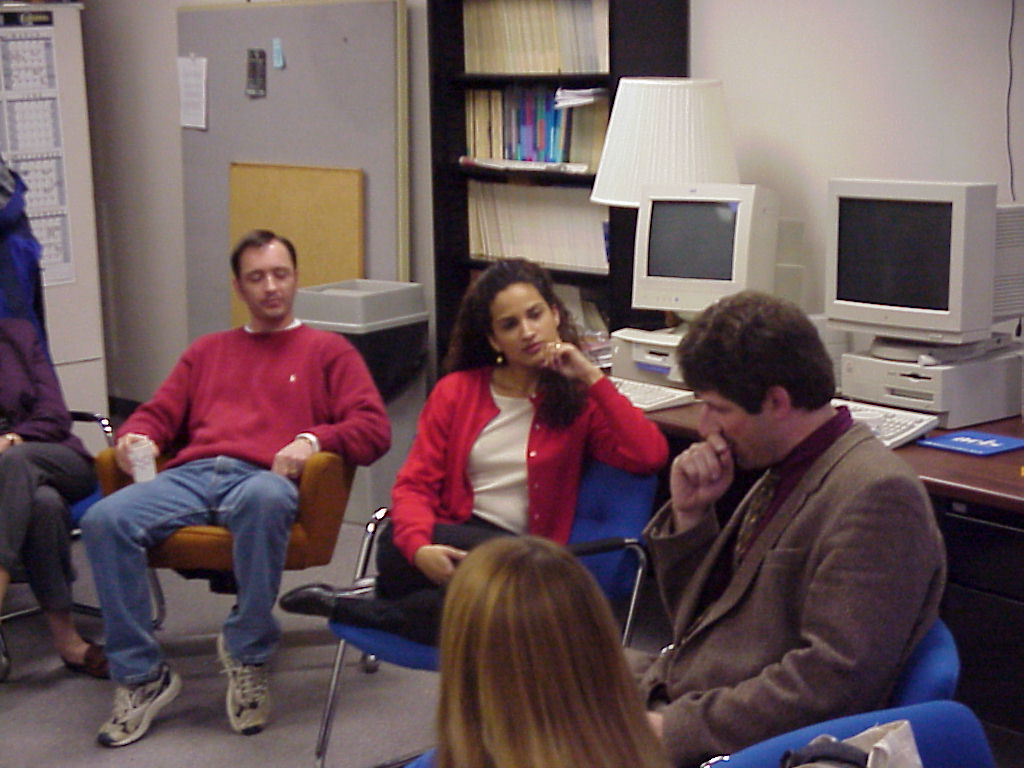
Our three heroic "New Faculty
Members." From left to right: Anthony "Tony"
Roberto, Leola McClure, and Sorin Matei (Michael Tidwell has a
justified absence, which won't affect his final grade)
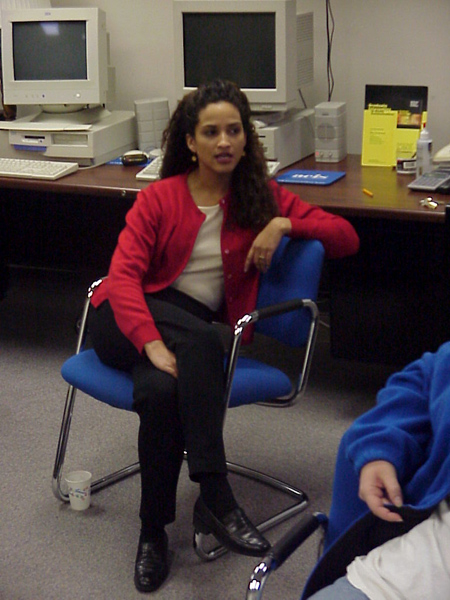
Leola McClure, who in the picture hinders the vision of
interesting pieces of paleo-tech, offered the grad students a
wealth of tips and suggestions and confirmed us that: "The
best dissertation is a dissertation done."
Anthony Roberto caught in a moment of
intense self-disclosure.
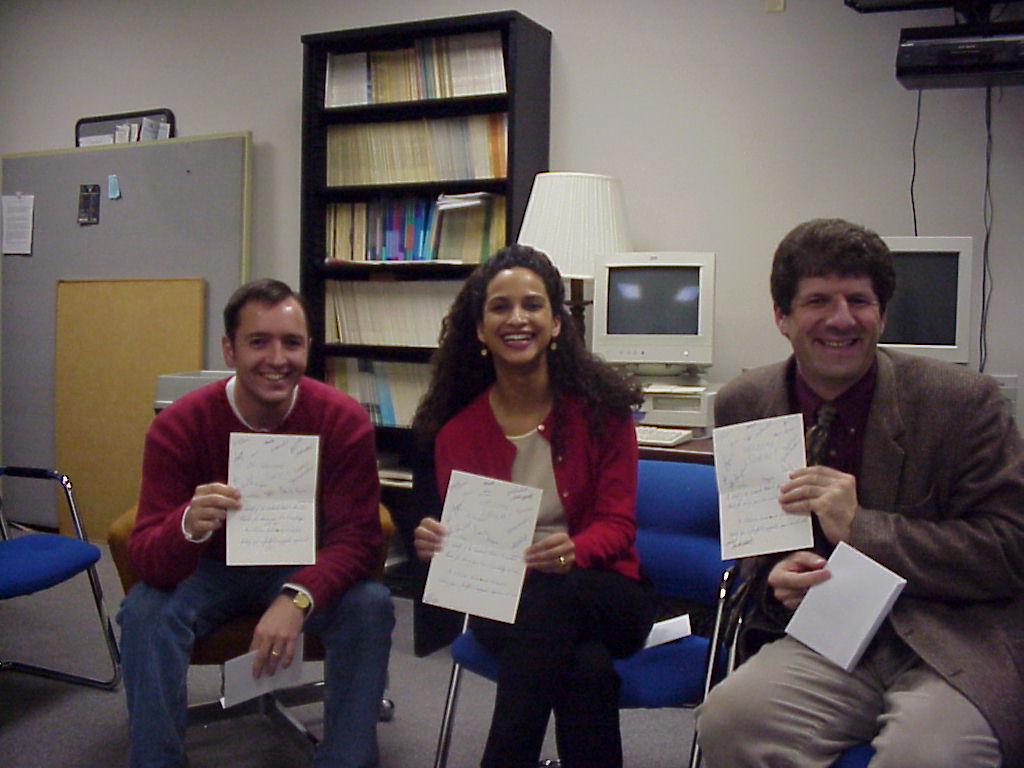
Everybody wins at the GSA Colloquia! The New Faculty Members with our
"Thank you"
cards. The meeting has been funny and interesting at the same
time. Amongst other things, we also
learnt that Dracula wasn't such a bad guy but he was victim of one
of the
first mass media campaigns! Thank you to everybody who participated
at the event!
>>TOP
Official
presentation of the PFCF course
On
Thursday, November 8th, Prof. Enid Waldhart and some members of
the PFCF Steering Committee have officially presented the course CJT 685 "Seminar in Preparing Future Faculty
for the Multicultural Communication Classroom" to the graduate
students.
Several
of our doctoral students have participated in the general PFF
courses currently available here on campus. And each has talked
about benefits they've received from having the opportunity to
learn about colleges and universities other than Research I
institutions. Not only do they hope that this will prepare
them to make informed choices about their future academic careers
but to be better future faculty members as a result.
The course CJT 685 "Seminar in Preparing Future Faculty
for the Multicultural Communication Classroom" is designed to
help graduate students further develop their teaching skills as
they consider the various aspects in teaching an increasingly
multicultural student body.
Schedule
Book states that this course is 3 credit hours and lists it as CJT
780. Please note: THIS IS AN ERROR. The course is one-credit
only: it is now correctly listed as CJT 685 "Seminar in Preparing Future Faculty
for the Multicultural Communication Classroom".
CJT
685 will meet Wednesday
afternoons from 1-3 in EGJ 223. The
course has been designed so that topics, readings, and the
expertise of many panelists will make it both exciting and
informative.
IF
YOU ARE INTERESTED IN TAKING THIS, YOU CAN USE THE SECONDARY
REGISTRATION WINDOW ON NOV. 20TH.
For
any questions, see or call Enid Waldhart (235 EGJ, tel. 257-2886)
or email her at waldhart@uky.edu.

The participants!
From left clockwise: Maria Spirankova, Prof. Enid Waldhart,
Donna Wills, Adel Iskandar, Mary Lee Matuza, Prof. James Hertog,
Prof. Derek Lane, Cartwright Stephens, Billy Wooten (not in the
picture: Annalise Bratcher and Davide Girardelli)

Jim and Cartwright
kept an eye on Derek: nobody got hurt during the
colloquium...
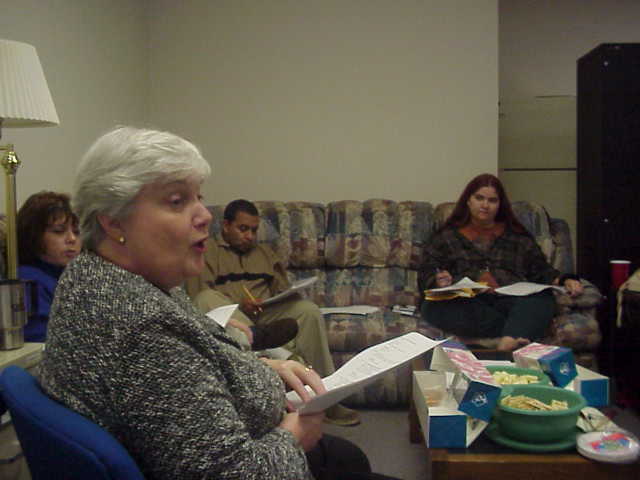
While Enid
explained the nuts and bolts of the CJT 685 course, Donna and
Mary Lee presented their own experiences with the campus-wide
PFF. Adel seems to be interested into the dialogue: in reality
he is aiming for the last donut in the box...
>>TOP
Holly
Payne's commentary on the first
page of the NCA PFF leaflet!!!
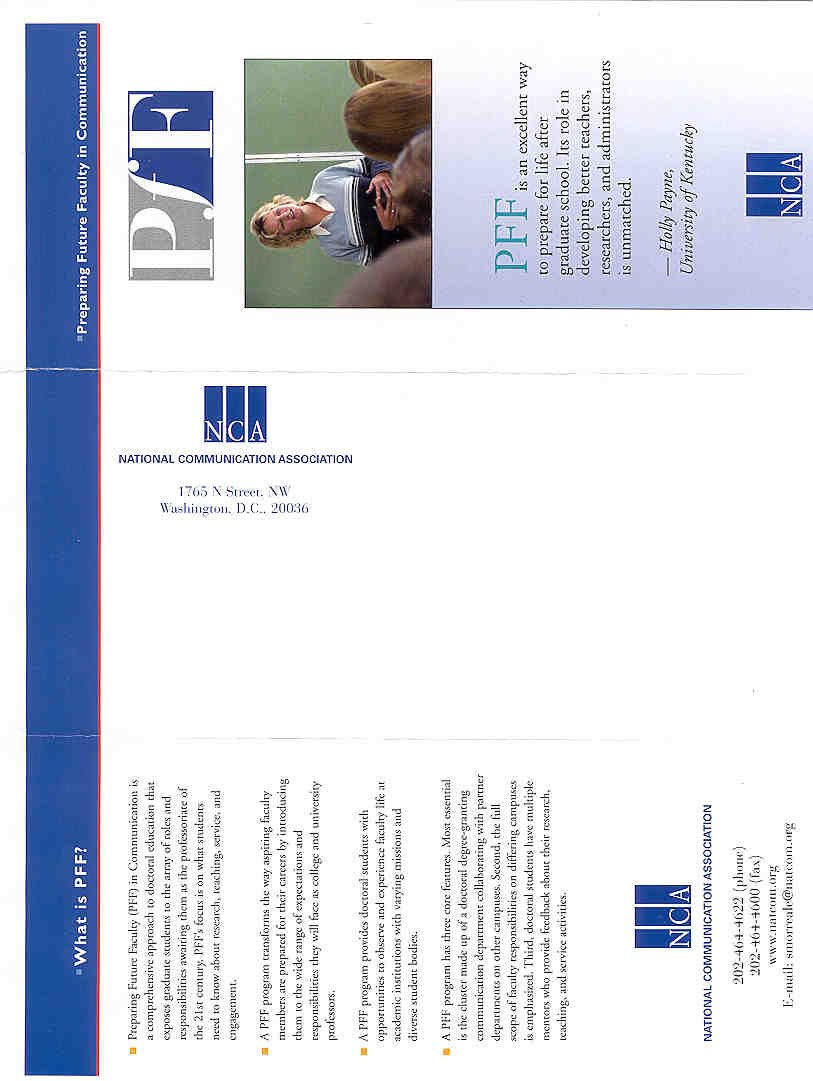
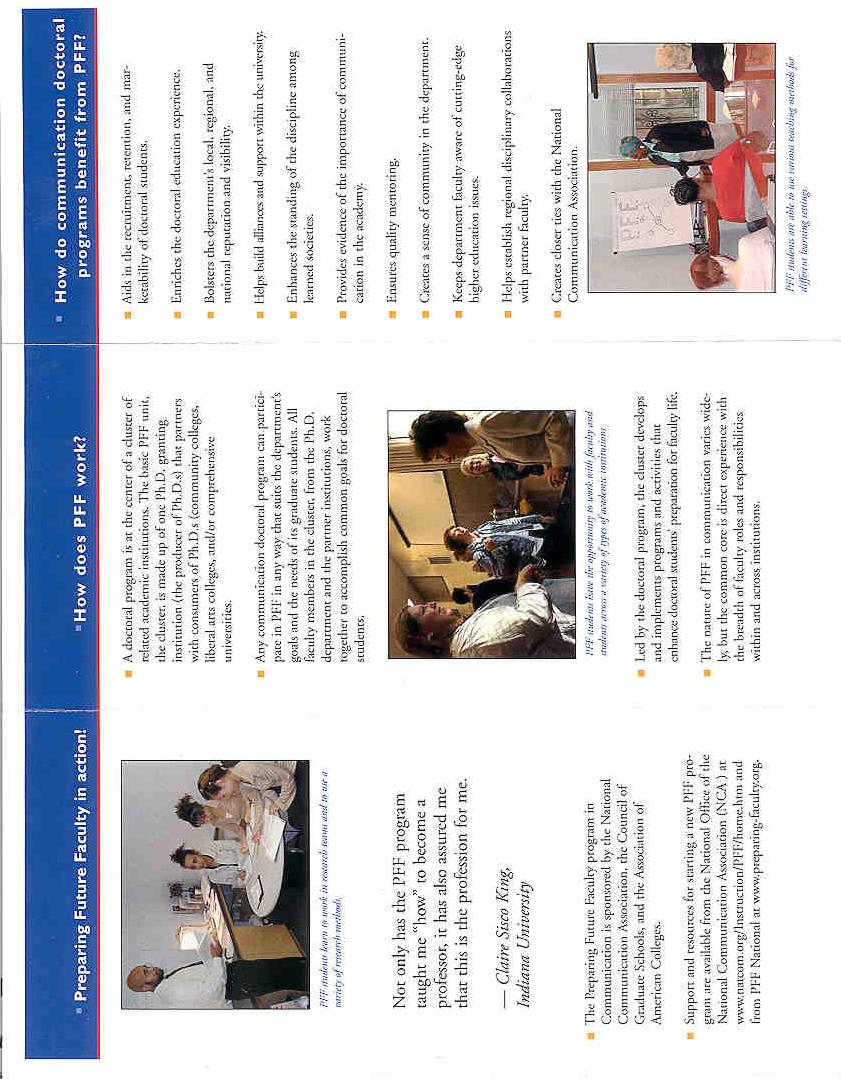
>>TOP
(PFF)
KCTCS Collaboration: The University of Kentucky’s Preparing
Future Faculty (PFF) program and the Kentucky Community and
Technical College System’s (KCTCS) offer a distance education
practicum experience.
!!!Graduate
Students!!!






